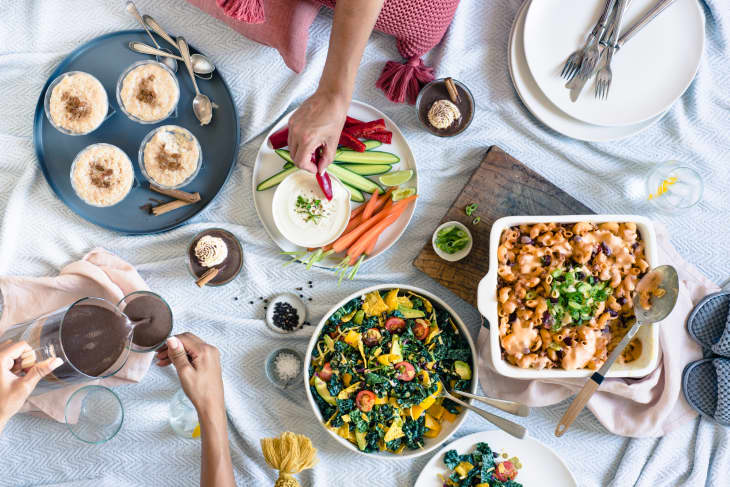How I Embraced the Coffee Table as the New Family Table
Last year, my husband and I sold our 2,400-square-foot suburban home in Atlanta to move across the country to Boise, Idaho. We landed in a much smaller, roughly 1,600-square-foot, home in the heart of downtown. What we gave up in a living space, we gained in community, health, and a much lower mortgage payment.
Our story is not unusual. As more young families are choosing to live in cities rather than suburbs or rent rather than own, or opting for smaller homes, formal dining spaces and their bigger dinner tables are becoming less ubiquitous. Even though we have a small dining area, we still eat about two-thirds of our meals at home at the coffee table.
For several months, I struggled to let go of the ideal that family dinner had to be at the dining table. But the reality is the coffee table made family meals easier — especially outside of dinner. Coffee table dining also made room for more guests and helped us make friends in our new town more quickly. Here’s how I made peace with coffee table meals and embraced it as the new family table.
Why the Coffee Table Is Better for Connecting
My 6-year-old answered the question of why the coffee table is better quickly and succinctly: “It’s just more fun to sit at the coffee table!” She’s not wrong. Coffee-table dining has a cool and casual vibe. Just like sitting at a fully dressed white-clothed table makes us sit up a little straighter and remember our manners, eating around the coffee table makes us relax more and laugh a little harder. Whether you want to call it a crappy dinner party or just dinner with friends, coffee-table dinners bend convention to make meals an invitation for deeper connections. At the coffee table, there’s literally less space between you and your family or guests, and that matters.
Two weeks after moving into our smaller home, we invited our new neighbors over for cake to celebrate my youngest’s birthday. Panic set in the night before — we did not have enough dinner-table space for everyone! My husband reassured me that everything would be fine and set a few kid-sized step-stools around our coffee table and added two adult-sized floor pillows. The coffee table became the most coveted spot at the party! The kids could play and eat their cake and there was more room in our living room to visit and get to know our neighbors with less formality. Being forced to quickly adapt to our new home, imperfect as it was, let me quickly connect with strangers who are now my community.
Once I let go of my ideals around dinner — especially that dinner with guests had to be at the table — I noticed that everyone let their guard down easily when eating at the coffee table. It was as if removing the formality from dining invited an intimacy to the meal.
How To Make the Coffee Table Work for Dinner
There are some practical concerns to consider when dining around a coffee table. Here are a few ways to make the most of the coffee table dinner, whether it is your primary dining table or not.
1. Use your everyday dinnerware — napkins and coaster included.
Just because you’re eating around the coffee table doesn’t mean that you have to use paper plates and napkins! It doesn’t even mean you need to skip a tablecloth or placemats, depending on the meal.
Associate editor Kelli Foster says, “Despite having a dining room table, we eat at the coffee table on the couch every night. We always use placemats and cloth napkins, which somehow makes it feel somewhat more ‘adult.'”
2. Lead by example.
Our Food Director, Hali Ramdene, believes showing guests how to be in your space is sometimes better than telling them. “With dinner guests, you have to lead by example. If you don’t care about coasters, whether feet can go on the sofa or on the table, you might have to be demonstrative of that before they’ll feel comfortable about what’s OK to do in your space. Sometimes we need to give others permission to be causal, and I find the best way to do it is by being casual about things ourself.”
3. Adapt the coffee table for little diners.
We have two cheap step-stools that we keep under the coffee table as kid seats. They elevate tiny diners to table height, which minimizes mess. Christine Gallary, Kitchn’s Food Editor at Large, added that when they have grown-ups at the dining table, they often cover their coffee table with a cloth and set the kid’s table there.
4. Spills happen — have paper towels close by.
If a spill happened in the kitchen, you’d be close to towels for cleanup. Spills, drips, and messes still happen at the coffee table, so make yourself and guests more comfortable by having extra napkins or paper towels on the coffee table when you sit down. Not only does this signal “spills happen and that’s okay” to guests, but it also means you’re not scrambling when it does.
5. Serve smart coffee-table eats.
There’s some debate among Kitchn editors about what you should and shouldn’t serve at the coffee table — especially for guests. Some say anything goes (me), while a few of us think easy-to-eat foods are best. Bowl foods — things like rice or noodle bowls, stews, and casseroles — are nicer to eat on the couch or on the floor because they don’t require a knife and fork. Snack and cheese boards are especially wonderful for entertaining, because they can be served with small plates and eaten between board games or TV show premieres.
Read More
Do you eat at the coffee table? Or are you Team Dining Room Table?
